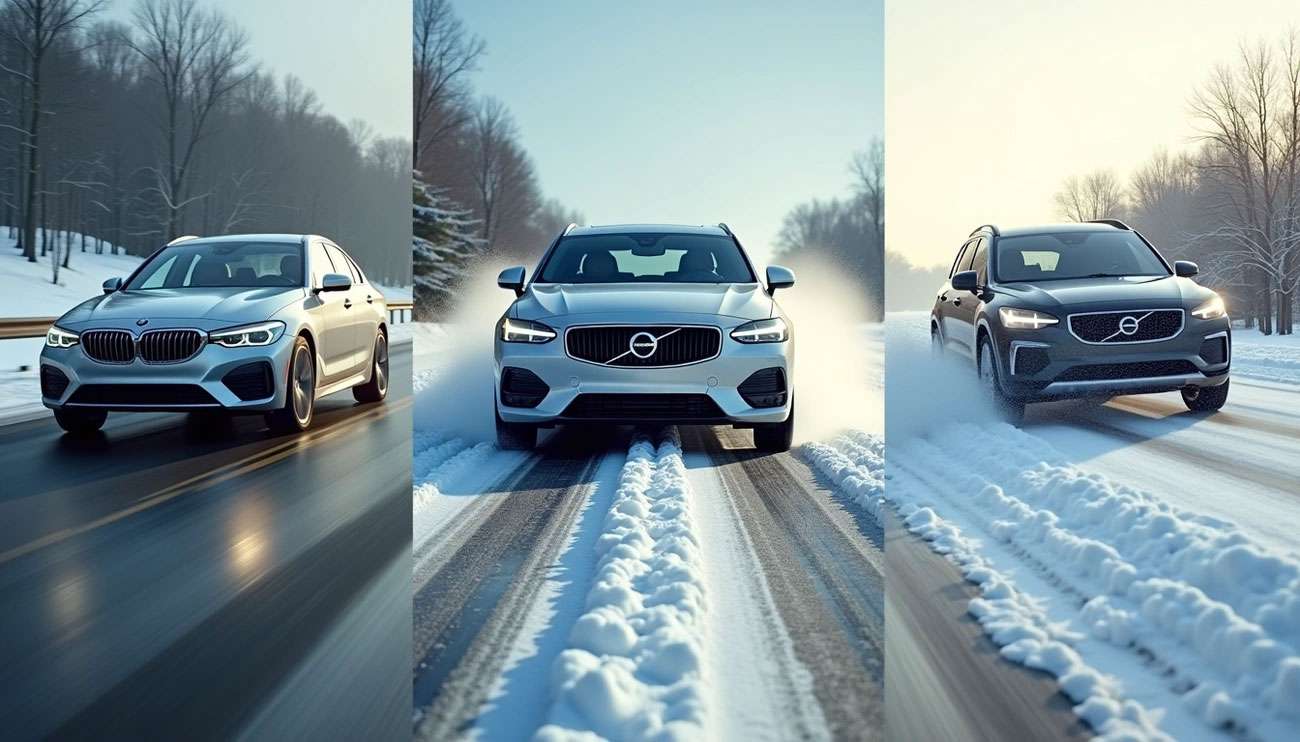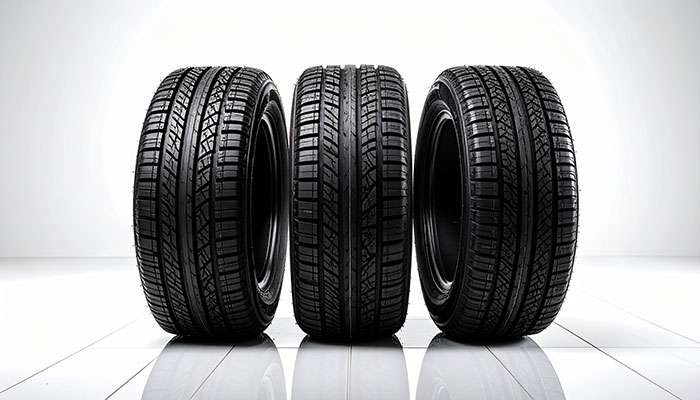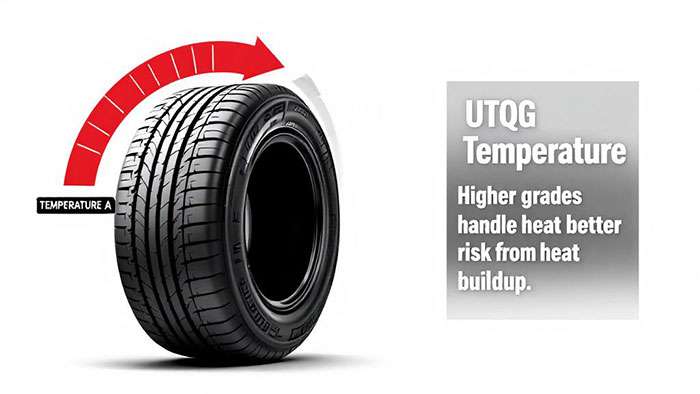
Choosing between all weather vs all season tires represents one of the most important safety decisions you'll make for your vehicle. While all-season tires achieve a mileage of around 35,000 km, they can struggle in extreme winter conditions, like heavy snow or icy roads. At Performance Plus Tire, we understand that tire selection directly impacts your safety and performance on the road.
All-season tires work best for mild climates that occasionally get snow or dip into freezing temperatures. All-weather tires maintain flexibility in colder temperatures while providing optimal performance throughout the year. The difference in stopping power tells the whole story: a typical car traveling at just 31 mph on snow will take 52 yards to come to a full stop with summer tires – a dangerous 26 yards more than if equipped with winter tires.
Your local climate determines which tire type will serve you best. All-weather tires carry the 3-Peak Mountain Snowflake (3PMSF) rating, qualifying them for harsher winter conditions. Winter tires maximize driver safety by reducing the risk of skidding, sliding, or loss of control during extreme winter weather. Whether you're facing harsh winters or mild seasonal changes, the right tire choice depends on understanding your specific climate needs and how different tire types perform in those conditions.
We've created this guide to help you understand the differences between all-season, all-weather, and winter tires so you can make the best choice for your vehicle and driving conditions.

Understanding tire types is essential before making a purchase decision. Each tire type is designed with specific characteristics that make them suitable for different weather conditions and driving needs.
All-season tires are built with a harder rubber compound designed to perform well on dry and wet roads through spring, summer, and fall. They begin to lose traction once temperatures drop below 7°C (45°F). Their smaller, low tread blocks reduce road noise and roll easily in warm weather.
These tires work best in mild climates that occasionally experience light snow or brief freezing temperatures. While they carry an M+S (Mud and Snow) rating, this doesn't qualify them as true winter tires. All-season tires offer greater longevity because of their harder compound, making them cost-effective for drivers in stable, predictable weather regions.
All-weather tires maintain flexibility both above and below 7°C, providing reliable grip on snow and slush without premature wear on bare asphalt. Their thicker tread blocks grip snow effectively, and their sipes efficiently push away slush and water, ensuring stability even in milder winters.
The key difference is that all-weather tires bear the Three-Peak Mountain Snowflake (3PMSF) symbol, certifying them for winter use. They represent an excellent compromise for drivers who experience unpredictable climate changes but don't require dedicated winter tires.
Winter tires are specifically engineered for winter conditions. They use a soft rubber compound that maintains flexibility in temperatures below 7°C, delivering superior grip, cornering, and braking on snow. Their deep, chunky tread blocks and sipes effectively clear snow and slush, maintaining crucial road contact.
Some winter tires feature optional metal studs strategically placed for extra traction on ice. Winter tires outperform all-season tires as soon as temperatures drop into the low 40s, making them essential for areas with severe winters.
The primary distinction lies in their winter performance capabilities. Both types are designed for year-round use, but all-weather tires carry the 3PMSF certification, indicating they've passed specific traction requirements for reliable winter performance.
All-weather tires feature more aggressive tread patterns with additional sipes for improved winter traction. Where all-weather tires excel in winter performance, all-season tires typically offer greater longevity. Your optimal choice depends largely on your local climate conditions and seasonal weather variations.
Real-world testing reveals dramatic performance differences among tire types that can mean the difference between a safe stop and a collision. The numbers don't lie when it comes to how these tires perform under various conditions.
Despite both carrying the Three-Peak Mountain Snowflake symbol, winter tires undoubtedly outperform all-weather tires on snow and ice. Winter tires maintain flexibility in temperatures below -30°C with their softer rubber compounds, providing superior grip on icy surfaces. All-weather tires offer decent traction in light to moderate snow yet lack the specialized performance needed for extreme winter conditions.
The stopping distance differences are striking:
From 30 mph on snow-packed roads, winter tires stopped in approximately 59 feet, yet all-season tires required an additional 30 feet—equivalent to two car lengths
At just 12 mph on ice, winter-equipped vehicles stopped in 34 feet compared to 57 feet for all-season tires
These figures translate into a 30% reduction in braking distance with winter tires, potentially making the difference between a near miss and an accident.
All-weather tires excel in wet conditions with deeper grooves that efficiently channel water away from the contact patch. They reduce hydroplaning risk by providing improved water evacuation compared to all-season tires.
All-season tires deliver a smoother, quieter ride for daily driving in moderate climates. Their harder rubber compound means all-season tires typically last 60,000-80,000 miles versus 40,000 miles for winter tires, making them more economical for regions with stable weather patterns.

Your location and climate determine which tire type will serve you best. Different regions present unique challenges that require specific tire solutions.
All-season tires perform optimally in regions with mild weather patterns and minimal winter precipitation. These tires excel in temperatures consistently above 7°C (45°F). States like Illinois, Indiana, Ohio, and Wisconsin benefit from all-season tire performance year-round. The key advantage lies in their longevity and fuel efficiency for drivers who rarely encounter severe winter conditions. However, they become increasingly ineffective once temperatures drop below freezing, hardening and losing crucial traction.
All-weather tires shine in areas with variable weather patterns and moderate winters. They carry the Three-Peak Mountain Snowflake (3PMSF) certification, qualifying them as winter traction tires even in regions with legal winter tire requirements. These tires work effectively in temperatures both above and below 7°C, making them ideal for states with fluctuating conditions such as Maine, Vermont, New York, Michigan, and Minnesota. They eliminate the hassle of seasonal tire swaps while providing legal winter compliance.
Winter tires remain essential for areas experiencing consistent freezing temperatures, heavy snowfall, or icy conditions. Their specialized rubber compounds maintain flexibility even in extreme cold, providing optimal grip when temperatures consistently fall below 7°C. These tires should never be driven year-round as they wear rapidly in warmer conditions. Consider them a seasonal investment that pays dividends in safety and performance.
The 7°C (45°F) threshold serves as your critical indicator for tire changes. Install winter tires before temperatures consistently drop below this mark. Many drivers follow the "Thanksgiving to Tax Day" guideline—November through April—adjusting based on local climate conditions. Pay attention to morning temperatures, typically the coldest part of your commute, rather than afternoon highs when making your decision. This timing ensures maximum tire performance when you need it most.
Understanding the financial aspects of tire ownership helps you make the best decision for your budget and driving needs. Here's what you need to know about the costs associated with each tire type.
All-season tires typically outlast their counterparts with tread warranties ranging from 60,000 to 80,000 miles. All-weather tires offer comparable longevity with 40,000 to 80,000 miles of tread life. Winter tires wear significantly faster, lasting approximately 30,000 to 40,000 miles. Winter tires wear rapidly in temperatures above 7°C (45°F), markedly reducing their effective lifespan.
The longer tread life of all-season tires makes them cost-effective for drivers in stable weather regions. All-weather tires provide a good balance between longevity and winter capability. Winter tires require replacement more frequently but deliver essential safety benefits during cold months.
The deeper tread patterns of winter tires create higher rolling resistance, increasing fuel consumption by 5% to 15%. All-weather tires demonstrate better fuel economy than winter tires yet slightly less efficiency than all-season options. Low-rolling resistance tires can save drivers approximately $30 annually in fuel costs.
For budget-conscious drivers, all-season tires offer the best fuel economy. The increased fuel costs of winter tires should be weighed against their superior safety performance in cold conditions.
A basic tire swap costs about $10, while mounting and balancing without rims ranges from $60 to $80. Tire storage typically costs around $10 monthly. Over five years, seasonal tire changes may total roughly $1,000.
These additional costs make all-weather tires attractive for drivers who want winter capability without the hassle and expense of seasonal changes. Consider these ongoing expenses when comparing tire options.
Most tires include manufacturer warranties spanning 20,000 to 100,000 miles. Winter tires usually don't come with tread life warranties. Road hazard warranties cost between $10 and $20 per tire, primarily covering irreparable damage from road hazards.
When selecting tires, factor in warranty coverage alongside performance needs. All-season and all-weather tires typically offer better warranty protection than winter-specific options.
We've compiled this detailed comparison to help you understand the key differences between tire types. This table breaks down the essential characteristics that matter most when selecting the right tires for your vehicle and driving conditions.
Characteristic |
All-Season Tires |
All-Weather Tires |
Winter Tires |
Climate Suitability |
Mild climates with occasional light snow |
Variable climates with moderate winters |
Severe winter conditions |
Temperature Performance |
Loses traction below 7°C (45°F) |
Maintains flexibility above and below 7°C |
Best performance below 7°C |
Certification |
M+S (Mud and Snow) |
3-Peak Mountain Snowflake (3PMSF) |
3-Peak Mountain Snowflake (3PMSF) |
Tread Life |
60,000-80,000 miles |
40,000-80,000 miles |
30,000-40,000 miles |
Snow/Ice Performance |
Limited performance in extreme winter |
Good performance in light to moderate snow |
Superior grip and traction in snow/ice |
Compound Type |
Harder rubber compound |
Flexible compound |
Soft rubber compound |
Stopping Distance (30 mph on snow) |
Additional 30 feet compared to winter |
Not specifically mentioned |
Approximately 59 feet |
Best Use Period |
Year-round in mild climates |
Year-round in variable climates |
November through April ("Thanksgiving to Tax Day") |
Fuel Efficiency |
Best fuel efficiency |
Moderate fuel efficiency |
5-15% increased fuel consumption |
Tread Pattern |
Smaller, low tread blocks |
Thicker tread blocks with sipes |
Deep, chunky tread blocks with sipes |
This comparison shows the clear trade-offs between tire types. All-season tires offer the best longevity and fuel economy but sacrifice winter performance. Winter tires provide superior cold-weather safety but require seasonal changes and cost more to operate. All-weather tires split the difference, offering decent winter capability without the hassle of seasonal swaps.
Your choice depends on your local climate and driving priorities. We recommend choosing based on the harshest conditions you'll encounter, not average weather patterns.
The right tire choice comes down to matching your local climate with the appropriate tire technology. All-season tires deliver excellent value for drivers in mild regions with minimal winter precipitation, offering longer tread life and better fuel economy. They struggle significantly when temperatures drop below 7°C (45°F).
All-weather tires offer a practical solution for those living in variable climates. These tires carry the Three-Peak Mountain Snowflake certification, making them legally compliant in regions requiring winter traction tires while performing adequately year-round. They eliminate the hassle and expense of seasonal tire changes without matching specialized winter tire performance in extreme conditions.
Winter tires remain the best choice for cold-weather performance. Their specialized rubber compounds and aggressive tread patterns deliver superior grip, reducing stopping distances by up to 30% compared to all-season options. This performance difference can mean the difference between a safe stop and a collision during harsh winter conditions.
The 7°C (45°F) temperature threshold serves as your most reliable guideline for tire selection. Drivers experiencing temperatures consistently below this mark should consider either all-weather or dedicated winter tires. Safety must take precedence over convenience or cost considerations.
Your decision should factor in the practical aspects of ownership. Winter tires excel in cold conditions but wear rapidly in warmer weather and increase fuel consumption. All-season tires offer greater longevity but compromise winter safety. All-weather options balance these concerns with trade-offs in both directions.
Drivers in Michigan or Minnesota face different challenges than those in Georgia or California. Your local climate, driving habits, and safety requirements should guide your final decision. No tire performs perfectly in all conditions – the best choice depends on which performance aspects matter most for your specific situation.
Ready to find the perfect tires for your climate? Our expert team can help you select the right option based on your local weather patterns and driving needs.
Understanding the differences between tire types can dramatically improve your driving safety and help you make the right choice for your climate conditions.
• Temperature is the key deciding factor: All tires lose effectiveness below 7°C (45°F), making this the critical threshold for choosing between tire types.
• Winter tires reduce stopping distance by 30%: On snow-packed roads, winter tires stop 30 feet shorter than all-season tires from just 30 mph—potentially preventing accidents.
• All-weather tires offer the best compromise: They carry 3PMSF certification for winter use while eliminating seasonal tire swaps, ideal for variable climates.
• All-season tires last longest but sacrifice winter safety: With 60,000-80,000 mile tread life, they're economical for mild climates but dangerous in freezing conditions.
• Consider your local climate patterns: Drivers in consistently mild regions can use all-season tires, while those facing unpredictable winters should choose all-weather or dedicated winter options.
The right tire choice depends on balancing safety, cost, and convenience based on your specific driving conditions. Remember that winter performance differences can be life-saving—choose based on the harshest conditions you'll encounter, not average weather.
While not absolutely required, winter tires provide significant safety benefits in cold and snowy conditions. They offer superior traction and shorter stopping distances compared to all-season tires when temperatures drop below 45°F, potentially preventing accidents.
All-season tires are designed for year-round use in mild climates, while all-weather tires offer better performance in variable weather conditions. All-weather tires carry the Three-Peak Mountain Snowflake (3PMSF) certification for winter use, providing a compromise between all-season and dedicated winter tires.
The cost of winter tires varies, but you can expect to pay around $800 for a set of four, plus additional costs for mounting, balancing, and potentially separate wheels. However, using winter tires can extend the life of your regular tires, offsetting some of the cost over time.
It's generally recommended to switch to winter tires when temperatures consistently fall below 45°F (7°C). Many drivers follow the "Thanksgiving to Tax Day" guideline, installing winter tires in November and removing them in April, adjusting based on local climate conditions.
While all-wheel drive helps with acceleration in snowy conditions, it doesn't improve braking or cornering on ice and snow. Winter tires can significantly enhance overall traction and safety for all types of vehicles, including those with all-wheel drive.